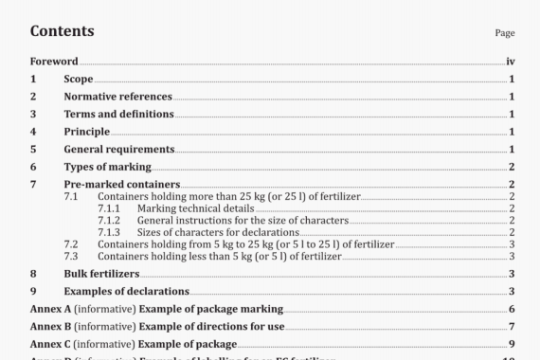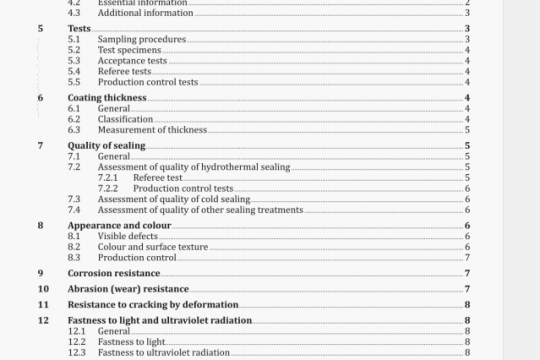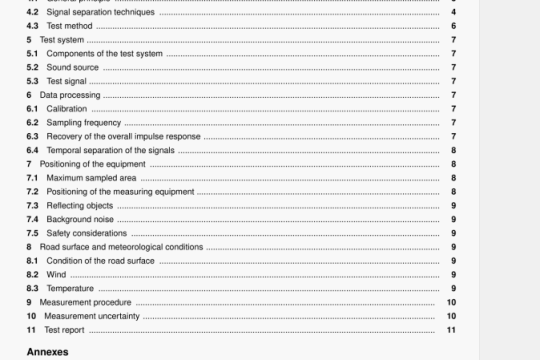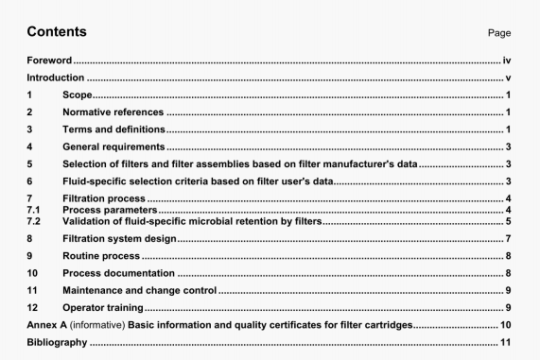ISO 15403:2000 pdf download
ISO 15403:2000 pdf download.Natural gas – Designation of the quality of natural gas for use as a compressed fuel for vehicles.
temperature above which no condensation of water occurs at a specified pressure
NOTE For any pressure lower than the specified pressure there is no condensation at this dew-point temperature.
[ISO 14532]
3.14
hydrocarbon dew point
temperature above which no condensation of hydrocarbons occurs at a specified pressure
NOTE 1 At a given dew point temperature there is a pressure range within which condensation occurs because of retrograde behaviour. The cricondentherm defines the maximum temperature at which condensation can occur.
NOTE 2 The dew point line is the locus of pressure and temperature points which separate the single phase gas from the gas-hydrocarbon liquid region.
3.15
molar composition
proportion of each component expressed as a molar (or mole) fraction, or molar (mole) percentage, of the whole
NOTE 1 Thus the mole fraction, x1, of component i is the quotient of the number of moles of component I and the number of moles of the whole mixture present in the same arbitrary volume. One mole of any chemical species is the amount of substance which has the relative molecular mass in grams. A table of recommended values of relative molecular masses is given in ISO 6976:1995.
NOTE 2 For an ideal gas, the mole fraction (or percentage) is identical to the volume fraction (percentage), but this relationship cannot in general be assumed to apply to real gas behaviour.
3.16
gas composition
fractions or percentages of the main components, associated components, trace components and other components determined from natural gas analysis [ISO 14532]
3.17
odorization
addition of odorants, normally intensively smelling organic sulfur compounds, to natural gas (normally odourless) to allow the recognition of gas leaks by smell at very low concentration (before a build up to a dangerous gas in air concentration can occur) [ISO 14532]
3.18
methane number
rating indicating the knocking characteristics of a fuel gas
NOTE It is comparable to the octane number for petrol. The methane number expresses the mole fraction expressed as a percentage of methane in a methane/hydrogen mixture which, in a test engine under standard conditions, has the same tendency to knock as the fuel gas to be examined.
[ISO 14532]
5 Gas composition requirements
5.1 Water
The single most important safety requirement of compressed natural gas (CNG) fuel is a very low water dew-point temperature to preclude the formation of liquid water at any time. Liquid water is a precursor to the formation of corrosive compounds through combination with components in natural gas, namely carbon dioxide and hydrogen sulfide. The combination of corrosive agents, and the pressure cycling, caused by fuel consumption and subsequent refilling of the fuel storage container, can result in crack growth in metals and ultimately damage and failure. Also, liquid water itself can be detrimental as it may cause blockages, both liquid and solid, in the fuel system.
Thus, the water dew-point of the fuel gas at the fuelling station outlet shall be sufficiently below the lowest ambient temperature in which fuelling stations and vehicles will operate.
5.2 Hydrocarbons
While hydrocarbon components contained in natural gas normally remain in the gaseous state in local distribution systems, the pressures and temperatures experienced by CNG may cause condensation. Changes in fuel composition due to revaporization of this liquid condensate at reduced tank pressures may affect the vehicle performance unless a self-adaptive system is applied.
In cases where the natural gas contains significant quantities of propane and butane, for example caused by peak- shaving operations, a liquid phase can be formed at elevated pressures and low temperatures because of their relatively low vapour pressure (see annex A).
Thus, to minimize such occurrences, the composition of compressed natural gas shall be such, that at any pressure, less than 1 % of a liquid condensate is formed at the lowest ambient temperatures and under the worst gas storage pressure conditions (see ISO 6570-1). Maximum condensation occurs at pressures between 2 500 kPa to 4 500 kPa.
5.3 Potential corrosive components
5.3.1 Sulfur-containing components
Some sulfur components are corrosive; the total sulfur content may have an adverse impact on exhaust gas cleaning devices and should be taken into consideration.
5.3.2 Hydrogen sulfide
Given that the corrosive environment is controlled by the lack of liquid water in accordance with 5.1, no extraordinary limitations are required on the concentration of hydrogen sulfide. Hydrogen sulfide in combination with oxygen may cause powdering, especially on copper, which can have detrimental effects on the system.
5.3.3 Carbon dioxide
Given that the corrosive environment is controlled by the lack of liquid water in accordance with 5.1, no extraordinary limitations are required on the concentration of carbon dioxide.
5.3.4 Oxygen
Given that the corrosive environment is controlled by the lack of liquid water in accordance with 5.1, no extraordinary limitations are required on the concentration of oxygen.




